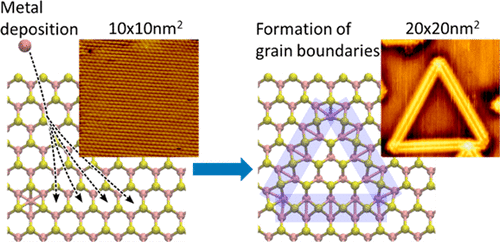Our official English website, www.x-mol.net, welcomes your
feedback! (Note: you will need to create a separate account there.)
Post-Synthesis Modifications of Two-Dimensional MoSe2 or MoTe2 by Incorporation of Excess Metal Atoms into the Crystal Structure
ACS Nano ( IF 15.8 ) Pub Date : 2018-04-09 00:00:00 , DOI: 10.1021/acsnano.8b01580
Paula Mariel Coelho 1 , Hannu-Pekka Komsa 2 , Horacio Coy Diaz 1 , Yujing Ma 1 , Arkady V. Krasheninnikov 2, 3 , Matthias Batzill 1
ACS Nano ( IF 15.8 ) Pub Date : 2018-04-09 00:00:00 , DOI: 10.1021/acsnano.8b01580
Paula Mariel Coelho 1 , Hannu-Pekka Komsa 2 , Horacio Coy Diaz 1 , Yujing Ma 1 , Arkady V. Krasheninnikov 2, 3 , Matthias Batzill 1
Affiliation

|
Phase engineering has extensively been used to achieve metallization of two-dimensional (2D) semiconducting materials, as it should boost their catalytic properties or improve electrical contacts. In contrast, here we demonstrate compositional phase change by incorporation of excess metals into the crystal structure. We demonstrate post-synthesis restructuring of the semiconducting MoTe2 or MoSe2 host material by unexpected easy incorporation of excess Mo into their crystal planes, which causes local metallization. The amount of excess Mo can reach values as high as 10% in MoTe2 thus creating a significantly altered material compared to its parent structure. The incorporation mechanism is explained by density functional theory in terms of the energy difference of Mo atoms incorporated in the line phases as compared to Mo ad-clusters. Angle resolved photoemission spectroscopy reveals that the incorporated excess Mo induces band gap states up to the Fermi level causing its pinning at these electronic states. The incorporation of excess transition metals in MoTe2 and MoSe2 is not limited to molybdenum, but other transition metals can also diffuse into the lattice, as demonstrated experimentally by Ti deposition. The mechanism of incorporation of transition metals in MoSe2 and MoTe2 is revealed, which should help to address the challenges in synthesizing defect-free single layer materials by, for example, molecular beam epitaxy. The easy incorporation of metal atoms into the crystal also indicates that the previously assumed picture of a sharp metal/2D-material interface may not be correct, and at least for MoSe2 and MoTe2, in-diffusion of metals from metal-contacts into the 2D material has to be considered. Most importantly though, the process of incorporation of transition metals with high concentrations into pristine 2D transition-metal dichalcogenides enables a pathway for their post-synthesis modifications and adding functionalities.
中文翻译:

通过将多余的金属原子结合到晶体结构中来进行二维MoSe 2或MoTe 2的合成后修饰
相工程已被广泛用于实现二维(2D)半导体材料的金属化,因为它可以提高其催化性能或改善电接触。相反,这里我们通过将过量的金属掺入晶体结构来证明组成相变。我们证明了半导体MoTe 2或MoSe 2主体材料的合成后重组,方法是通过意外地轻松地将多余的Mo掺入其晶面,从而引起局部金属化。MoTe 2中的过量Mo量可高达10%因此与母体结构相比,其材料发生了显着变化。结合机理通过密度泛函理论来解释,与在分子簇中相比,在线相中结合的Mo原子的能量差。角度分辨光发射光谱法表明,掺入的过量Mo会引起能带隙态达到费米能级,从而导致其钉扎在这些电子态上。在MoTe 2和MoSe 2中掺入过量的过渡金属不仅限于钼,而且其他过渡金属也可以扩散到晶格中,如通过Ti沉积实验证明的那样。MoSe 2和MoTe 2中过渡金属的结合机理揭示了这将有助于例如通过分子束外延法解决合成无缺陷单层材料的挑战。金属原子容易掺入晶体还表明,先前假定的清晰的金属/ 2D材料界面图片可能不正确,至少对于MoSe 2和MoTe 2而言,金属从金属触点向金属的扩散必须考虑2D材质。不过,最重要的是,将高浓度过渡金属掺入原始2D过渡金属二卤化物的过程为合成后修饰和增加功能性提供了途径。
更新日期:2018-04-09
中文翻译:

通过将多余的金属原子结合到晶体结构中来进行二维MoSe 2或MoTe 2的合成后修饰
相工程已被广泛用于实现二维(2D)半导体材料的金属化,因为它可以提高其催化性能或改善电接触。相反,这里我们通过将过量的金属掺入晶体结构来证明组成相变。我们证明了半导体MoTe 2或MoSe 2主体材料的合成后重组,方法是通过意外地轻松地将多余的Mo掺入其晶面,从而引起局部金属化。MoTe 2中的过量Mo量可高达10%因此与母体结构相比,其材料发生了显着变化。结合机理通过密度泛函理论来解释,与在分子簇中相比,在线相中结合的Mo原子的能量差。角度分辨光发射光谱法表明,掺入的过量Mo会引起能带隙态达到费米能级,从而导致其钉扎在这些电子态上。在MoTe 2和MoSe 2中掺入过量的过渡金属不仅限于钼,而且其他过渡金属也可以扩散到晶格中,如通过Ti沉积实验证明的那样。MoSe 2和MoTe 2中过渡金属的结合机理揭示了这将有助于例如通过分子束外延法解决合成无缺陷单层材料的挑战。金属原子容易掺入晶体还表明,先前假定的清晰的金属/ 2D材料界面图片可能不正确,至少对于MoSe 2和MoTe 2而言,金属从金属触点向金属的扩散必须考虑2D材质。不过,最重要的是,将高浓度过渡金属掺入原始2D过渡金属二卤化物的过程为合成后修饰和增加功能性提供了途径。































 京公网安备 11010802027423号
京公网安备 11010802027423号